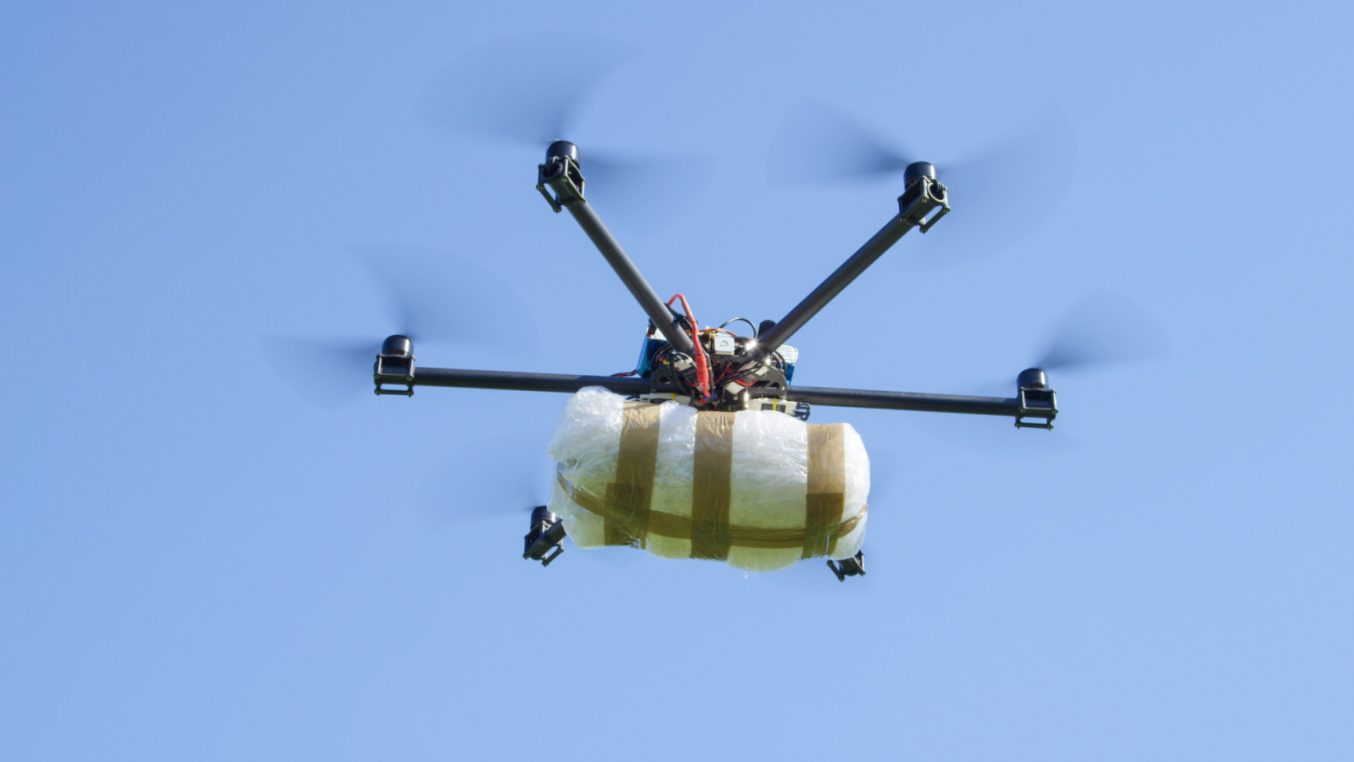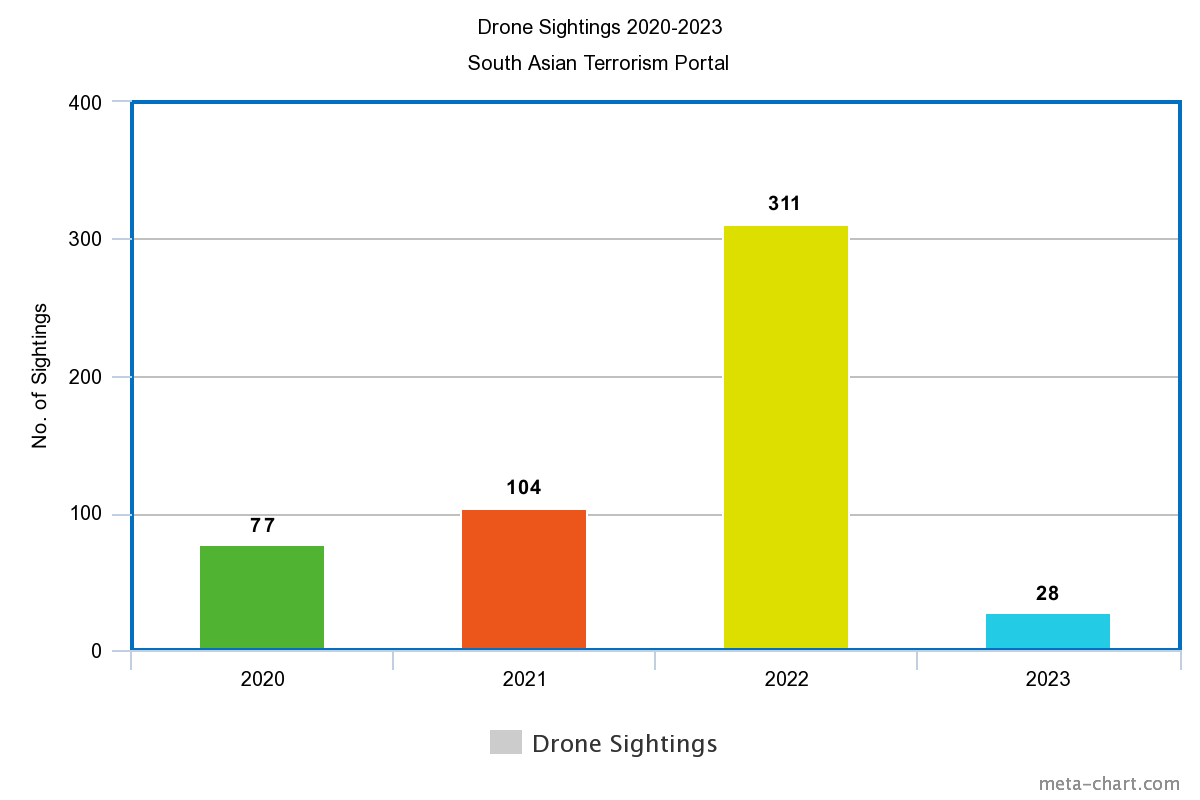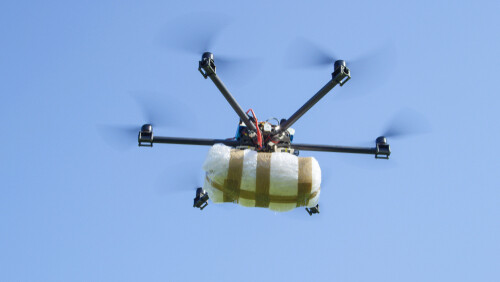Abstract: Punjab, a state in north-western India, has become a hotspot for recreational drugs, leading to smugglers keeping a stronghold over the supplies. Further, drone technology actively supports drug activity, supplying arms, ammunition, and drugs to the state. Investigations by security agencies and Punjab Police show a linkage to Pakistan-based druglords, who use farmers and labourers from across the border as the carriers of narcotics. In this context, it is pertinent to understand the dual strategy of infiltrating the Indo-Pakistani border using drugs and drones.
Problem statement: How to address the security and drug menace in Punjab?
So what?: The Indian security forces need to train in sensing and countering the danger posed by aerial systems, and collaboration between the central and state governments must be increased. Due to increasing unemployment, it becomes a primary duty of the state government to facilitate employment opportunities to reduce dependence on drugs. By doing so, smugglers across the border will find it difficult to exploit such socio-economic inadequacies.

Source: shutterstock.com/Flystock
A Sensitive Border State
Punjab, the land of five rivers, previously known for its agricultural prowess and contribution to India’s freedom struggle, has been witnessing an increasing trend in unemployment, drug menace, and gangsterism.[1] The state witnessed more than a decade of militancy from 1971 to 1992, with Khalistan factions demanding a separate state for the Sikhs. As for the drug problem, by tracing the pattern of drug routes, it can be deduced that some drugs enter Punjab from neighbouring states — charas through Himachal Pradesh; opium and poppy husk from Rajasthan and Madhya Pradesh.[2] However, given its proximity to the Golden Crescent region, a global site for opium production and distribution, Punjab also gets its drug supplies from syndicates in neighbouring countries, such as Pakistan.
In the rising drug menace, the central and state governments have become wary of the drug abuse situation and improved arrangements, such as the establishment of rehabilitation centres and tracking sources of drug supplies, to eliminate the usage of narcotics. However, the crackdown by state apparatus has led external forces, such as Pakistan’s drug syndicates, to use drone technology to supply consignments of drugs and contraband. India’s Border Security Force (BSF) has reported nearly 268 incidents of drone sightings around the international border, particularly in the Tarn Taran, Fazilka, and Amritsar regions of Punjab in 2022.[3] The Indian security forces are perplexed by the dual nature of the tragedy as the incoming drone activity flags serious security threats, which, when combined with drug usage, may possibly lead to anti-national sentiments cropping up again in Punjab after three decades. Punjabi youth’s inclination towards drug usage provides a fertile ground for anti-social elements to capitalize on latent conflicts. Therefore, Punjab, a sensitive border state, is vital in ensuring national security. The incursion by drones puts security apparatus in flux.
The crackdown by state apparatus has led external forces, such as Pakistan’s drug syndicates, to use drone technology to supply consignments of drugs and contraband.
Udta[4] Punjab – A Drug Addict’s Paradise
Looking at Punjab’s social demography and the occupational trends, it is clear that substances such as opium (known locally as kali nagini (black serpent) or afeem) have been in use for a long time.[5] Punjab is an agricultural state, and farming is an intensive activity, requiring sleepless nights to look after the fields. Therefore, taking drugs as an energy booster is acceptable in the Punjabi farming community.[6] However, in 1985, the enforcement of the Narcotics Drugs and Psychotropic Substances (NDPS) Act banned poppy cultivation in Punjab. Amid rising demand and curtailed supply, the ban increased the youth’s leaning toward synthetic drugs, such as heroin or chitta.[7]
With the ban on in-house cultivation, Punjab’s drug requirements are met by the bustling Golden Crescent route. The Golden Crescent region includes the countries of Afghanistan, Iran, and Pakistan. Being on the international border, Punjab enjoys a supply of illicit opium originating in Afghanistan, which reaches India via Pakistan. The drug market is a lucrative business, as a drug’s price increases with distance, and therefore a kilogram of heroin in Afghanistan will cost around one lakh Indian rupees ($1,223). Whereas, upon reaching the international market, its price goes up to five crores ($611,654).[8] The Indo-Pakistani border has become a drug gateway, as smugglers use rivers, streams, and old techniques of throwing off small consignments across borders. Smugglers are in constant touch with the couriers on the Indian side, who are ordinary farmers, labourers, and drug addicts.[9]
Smugglers prefer to recruit a drug addict for the smuggling of drugs, as the smuggling runs like a pyramid scheme, with the carrier getting a commission. Drug trafficking around the international border includes farmers, labourers, and police officials. According to a report by The Tribune, more than 100 police personnel have been arrested for illegal drug smuggling since 2014.[10] The report is alarming, as the same officials are responsible for ensuring the state’s security.
According to a report by The Tribune, more than 100 police personnel have been arrested for illegal drug smuggling since 2014.
Many factors play a role in the increased consumption and distribution of synthetic drugs, such as heroin. Being an agriculture-oriented state, Punjab’s economic output predominantly comes from farming. However, Punjab has recorded a growth rate of only 4% in 2022, whereas its unemployment rate is at 6.8%.[11] The unemployment in Punjab is due to the lack of industries, relevant education opportunities, low pay in private sector jobs, and competitiveness in job markets, among other factors, which pushes many Punjabi youth to take up drug use.[12] Apart from the lack of industries and unemployment, Punjab’s music industry also glorifies the usage of drugs through songs.[13]
Being a border state, Punjab has come under the scanner for being a haven for drug lords and kingpins, who disguise themselves as ordinary citizens and clear security checks on the international border. Punjab’s drug addiction has become its weakness, used by neighbouring Pakistan and its agencies to wage a narcotics war against India, in general, and in the border state, in particular.
Pakistan’s Narco-Terrorism In Punjab
Pakistan’s Inter-Services Intelligence (ISI) has adopted the strategy of using narcotics to destroy Punjab’s youth cognitively.[14] The worst affected districts include Tarn Taran, Amritsar, Hoshiarpur, and Ferozpur. While addressing a press conference on February 13, 2023, Punjab’s Inspector General of Police (IGP) Sukhchain Singh Gill announced that the Punjab Police had arrested 10,576 drug smugglers in the preceding seven months. In addition to the arrests, around 667.03 kg of heroin, 423 kg of opium, 25,548 kg of poppy husk, and 5,149,882 kg of medical drugs were also recovered under a special campaign to curb the drug menace in the state.[15]
Pakistan’s drug lords have traditionally used orthodox methods to transport drugs via the border. However, with increased patrolling along the border, advanced technology has aided these Pakistan-based smugglers. The usage of drones to supply drugs, arms, ammunition, and explosives came to light in 2019.[16] According to reports, drone sightings along the international border, covering states like Jammu and Kashmir, Punjab, Rajasthan, and Gujarat, have increased manifold. The sightings numbered around 77 in 2020, 104 in 2021, 311 in 2022, and 28 in the first four months of 2023; whereas the BSF successfully downed nearly 22 drones in 2022.[17]
With increased patrolling along the border, advanced technology has aided these Pakistan-based smugglers. The usage of drones to supply drugs, arms, ammunition, and explosives came to light in 2019.

Source: The author has compiled and analysed news reports from South Asia Terrorism Portal; https://www.satp.org/terrorist-activity/india-punjab
The usage of drones has become a threat to India’s national security without anti-drone technology in place. It becomes difficult for the security forces to track the device. In the recently held UN Security Council’s open debate on ‘Threats to International Peace and Security: Risks Stemming From Violations of Agreements Regulating the Exports of Weapons and Military Equipments’ India’s Permanent Representative to the UN Ruchira Kamboj asserted that India is facing a severe challenge of cross-border supply of weapons using drone technology.[18] The drones infiltrating the Indo-Pakistani border have been documented to drop off weapons to be used by anti-social elements.[19] In taking down drones in 2022, BSF has remained largely successful, seizing around “316.988 kg of heroin, 67 weapons, and 850 rounds, and killed two Pakistani nationals and apprehended 23 Pakistani nationals in different incidents.”[20]
Drone Technology and Need for India’s Comprehensive Response
Punjab’s situation is two-dimensional as the state witnesses an influx of drugs and the increased usage of advanced technology, such as Unmanned Aerial Systems (UAS) or drones, to supply arms, ammunition, and drugs.[21] The use of drones in remote warfare has become quite widespread over the last two decades. Due to their flexible usage, drones have the capacity to impact traditional, environmental, and human security. In a modern sense, drone usage is the equivalent of aircraft deployment in the First World War as it essentially transforms modern warfare. Drones are used for military purposes and surveillance during disaster management, agriculture, and environmental security. If used positively, drones can enhance human security and detect threats. However, the easy availability of drones has led the state and non-state actors to use the technology against neighbours. Drug lords in Pakistan have begun using drones to smuggle drugs and arms across the border. Due to their flying capability and built design, the drones are disguised effectively. The two-dimensional nature has complicated the security forces’ response.
The easy availability of drones has led the state and non-state actors to use the technology against neighbours.
India’s response to the situation has been swift. The central government, in 2021, extended the jurisdiction of BSF in Punjab, Assam, and West Bengal from 15km to 50 km from the international border to the hinterland. The BSF has the power to search, seize, and arrest individuals under suspicion inside their jurisdiction.[22] The extension has been significant in tracking drug consignments, giving the security forces more power to ensure the region’s security. Since the extension, BSF has intercepted more than 20 drones carrying arms, ammunition, and drugs.
Way Forward
In the context of smugglers using drone technology, the Indian security forces have successfully intercepted many drone systems. However, the number of proliferations increases with each passing day. Therefore, the BSF and Punjab Police must train the forces in tackling drone technology. The mere proliferation of drone technology on the Indian side will not help address a deeper web of narco-terrorism, as the forces need special training in sensing the danger posed by such aerial systems. It is essential to understand that the situation is grave and requires a coordinated response with increased collaboration between the central and state governments. The state government has taken many initiatives by opening de-addiction centres;[23] however, they have yet to be successful. On the economic front, the state government must generate employment opportunities for the youth and increase awareness campaigns against the use of drugs.
The central government and state government in Punjab can collaborate comprehensively on issues such as extending the BSF jurisdiction up to 50 km, from the border inwards. The extension can be used as an asset to intercept incoming drones with the help of the Punjab Police and BSF. Moreover, the Punjab government should focus on training the state police in anti-drone technology as the nature of warfare is changing. Apart from collaboration, the governments at both levels must invest in anti-drone technology which can detect and intercept drones and further warn off the security forces. The armed forces have entered into contracts with Indian companies and ordered Indian-made anti-drone systems following drone attacks on the Jammu Air Force Station in June 2021.[24]
Apart from collaboration, the governments at both levels must invest in anti-drone technology which can detect and intercept drones and further warn off the security forces.
Although the kingpins of the drug supply chain are situated in Pakistan, the police personnel and drug addicts are mules for supplying drugs to a wider population in Punjab. Keeping this in mind, the state government in Punjab needs to increase the number of de-addiction centres and rehabilitate drug addicts to make them an asset to society. Additionally, police personnel should be subjected to rigorous training, focusing on implementing measures against personnel who take on becoming carriers for drug lords.
Conclusion
Youth in Punjab have become victims of addiction to synthetic drugs, such as heroin, due to widespread unemployment and economic slowdown in the state. Drug-related incidents and deaths have become common in rural and urban Punjab in the past few years. From March-December 2022, nearly 190 drug-related deaths were reported in Punjab.[25] Coupled with narcotics, the threat of re-emergence of the desire to form a separate Sikh state has also caught security forces off guard. Such a scenario calls for concerted efforts and initiatives on the part of the government and citizens, as narco-terrorism is a broader security threat.
Punjab has been an agriculture basket of India. However, recent years have seen the state going down the drain with a lack of industries and employment opportunities. The state is being flooded with narcotics from across the border. Therefore, the twin combination of narco-terrorism with the help of drone technology needs a better response from the government, security forces, and the public.
Shivam Tiwary served as a Management Trainee with MitKat Advisory Services in Mumbai. His areas of interest include India’s domestic politics, geopolitical risk analysis, internal security threats, and international events impacting India’s policies. Additionally, he has published articles on the growth of Indian unicorns, national waterways, Bihar’s political crisis, the re-emergence of Khalistan, and the impact of US involvement in the Ukraine War on the Indo-Pacific Strategy. He graduated with a BA in Journalism from Panjab University, Chandigarh, in 2020. He is pursuing his Master’s in International Studies from CHRIST (Deemed to be University), Bangalore. The views contained in this article are the authors’ alone.
[1] “Drug, drones, and death: Inside Punjab’s tragic stories of addiction,” The New Indian Express, November 02, 2022, https://www.newindianexpress.com/magazine/2022/oct/30/drug-drones-and-death-inside-punjabs-tragic-stories-of-addiction-2512309.html.
[2] Sameer Patil, “Punjab’s Unshakable drug smuggling networks,” Gateway House, April 18, 2018, https://www.gatewayhouse.in/punjabs-drug-smuggling/.
[3] “At 268, drone sightings along border with Pak double in 2022,” The Economic Times, December 01, 2022, https://economictimes.indiatimes.com/news/india/at-268-drone-sightings-along-border-with-pak-double-in-2022/articleshow/95894404.cms?from=mdr.
[4] Udta, a Hindi-language word, meaning flying. Udta in Udta Punjab signifies the situation of drug addicts after getting ‘high’.
[5] “Should Punjab government legalise opium? Here’s what leaders have to say,” India Today, October 03, 2018, https://www.indiatoday.in/mail-today/story/should-punjab-government-legalise-opium-here-s-what-leaders-have-to-say-1354396-2018-10-02
[6] “Here is why drug overdose deaths continue to haunt Punjab,” India Today, December 23, 2022, https://www.indiatoday.in/india/story/special-report-drug-overdose-deaths-continue-to-haunt-punjab-2312520-2022-12-23.
[7] “Legalising Opium Cultivation Will Boost Farmers’ Income, Dilute Menace of Synthetic Drugs in Punjab,” News18, January 2023, https://www.news18.com/news/opinion/legalising-opium-cultivation-will-boost-farmers-income-dilute-menace-of-synthetic-drugs-in-punjab-6838453.html.
[8] “The roots of drug addiction that plagues Punjab,” India Today, June 01, 2014, https://www.news18.com/news/opinion/legalising-opium-cultivation-will-boost-farmers-income-dilute-menace-of-synthetic-drugs-in-punjab-6838453.html.
[9] “The Chitta Economy: How the Business of Drugs Works in Punjab,” The Economic Times, September 01, 2018, https://economictimes.indiatimes.com/news/et-explains/the-chitta-economy-how-the-business-of-drugs-works-in-punjab/articleshow/65634397.cms?from=mdr.
[10] “Punjab Police battles ‘drug taint’,” The Tribune, July 05, 2022, https://www.tribuneindia.com/news/archive/punjab/punjab-police-battles-drug-taint-615877.
[11] “Unemployment data: Punjab better than national average; in Haryana, every third person is jobless,” The Indian Express, January 04, 2023, https://indianexpress.com/article/cities/chandigarh/unemployment-data-punjab-better-than-national-average-in-haryana-every-third-person-is-jobless-8359794/
[12] Sumandeep Kaur, “The ‘Drug Menace’ in Punjab: Causes, Consequences, and Policy Challenges,” Global Institute for Sikh Studies, 28(1), 41-51.
[13] “End glorification of drugs through songs,” The Tribune, July 11, 2018, https://www.tribuneindia.com/news/archive/amritsar/end-glorification-of-drugs-through-songs-618610.
[14] “Pak-based Ultras using Punjab based smugglers to fuel narco terror,” The Tribune, October 26, https://www.tribuneindia.com/news/j-k/pak-based-ultras-using-punjab-smugglers-to-fuel-narco-terror-444639.
[15] “Punjab Police arrest 10,576 drug smugglers in seven months,” The Hindu, February 14, 2023, https://www.thehindu.com/news/national/other-states/punjab-police-arrest-10576-drug-smugglers-in-seven-months/article66507354.ece.
[16] “200 aerial intrusions in Punjab recorded by BSF since January,” The Tribune, November 22, 2022, https://www.tribuneindia.com/news/punjab/200-aerial-intrusions-in-punjab-recorded-by-bsf-since-january-455679.
[17] “Drone sighting along border with Pak tripled in one year; 311 observations in 2022,” ANI, December 26, 2022, https://www.aninews.in/news/national/general-news/drone-sighting-along-border-with-pak-tripled-in-one-year-311-observations-in-202220221226201312/.
[18] “India facing ‘serious challenge’ preventing drone-driven cross-border supply of illicit weapons: Amabssador Kamboj at UNSC,” The Hindu, April 11, 2023, https://www.thehindu.com/news/national/india-facing-serious-challenge-of-cross-border-supply-of-illicit-weapons-using-drones-ambassador-kamboj-at-unsc/article66723738.ece.
[19] “Terror Drones from Pakistan demand a comprehensive national security response,” Firstpost, March 12, 2023, https://www.firstpost.com/opinion/terror-drones-from-pakistan-demand-a-comprehensive-national-security-response-12278102.html.
[20] “BSF in Punjab killed Pak intruders, captured 22 drones, seized 316 kg drugs this year,” ANI, December 31, 2022, https://www.aninews.in/news/national/general-news/bsf-in-punjab-killed-pak-intruders-captured-22-drones-seized-316-kg-drugs-this-year20221231134722/.
[21] “Drone incursions on rise: New form of Cross-Border Terrorism,” India Defence Review, December 08, 2022, http://www.indiandefencereview.com/drone-incursions-on-rise-new-form-of-cross-border-terrorism/.
[22] “Blueprint Defining Extended 50 km Jurisdiction of Border Security Force in Punjab, Bengal, and Assam Ready,” Swarajya, June 13, 2022, https://swarajyamag.com/news-brief/blueprint-defining-extended-50-km-jurisdiction-of-border-security-force-in-punjab-bengal-and-assam-ready.
[23] “Punjab Govt plans to raise number of de-addiction centres to 500,” The Tribune, May 07, https://www.tribuneindia.com/news/punjab/punjab-govt-plans-to-raise-number-of-de-addiction-centres-to-500-392782.
[24] “Anti-drone plan: How India is strengthening its unmanned warfare power,” India Today, September 07, 2021, https://www.indiatoday.in/india/story/anti-drone-plan-india-is-strengthening-its-unmanned-warfare-power-1850285-2021-09-07
[25] “Here is why drug overdose deaths continue to haunt Punjab,” India Today, December 23, 2022, https://www.indiatoday.in/india/story/special-report-drug-overdose-deaths-continue-to-haunt-punjab-2312520-2022-12-23.






